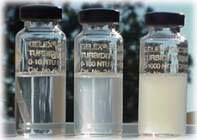Turbidity
Turbidity is a measure of how well light penetrates water. It is caused by particles (total suspended or dissolved solids) that are generally invisible to the naked eye. The measurement of turbidity is a key test of water quality.

Fluids can contain suspended particles of many different sizes. Some suspended material will be large enough and heavy enough to settle rapidly to the bottom if a liquid sample is left to stand. Very small particles settle very slowly or not at all if the sample is regularly agitated or the particles are colloidal. These small solid particles cause the liquid to appear turbid or murky.
Causes
changeTurbidity in open water may be caused by growth of phytoplankton.[1] Naturally occurring Algal blooms can cause turbidity. Human activities that disturb land can lead to high sediment levels entering water bodies during rain storms due runoff. These can include construction, mining and agriculture. pollution from paved surfaces such as roads, bridges and parking lots is another source.[2] Certain industries such as quarrying, mining and coal recovery can generate very high levels of turbidity from rock particles entering the water.
In drinking water, the higher the turbidity level, the higher the risk that people may develop diseases.[3] Contaminants like viruses or bacteria can become attached to the suspended solids. The suspended solids interfere with water disinfection with chlorine because the particles act as shields for the virus and bacteria. Similarly, suspended solids can protect bacteria from ultraviolet (UV) sterilization of water.[source?]
In water bodies such as lakes, rivers and reservoirs, high turbidity levels can reduce the amount of light reaching lower depths. This can limit growth of submerged aquatic plants. In turn this affects species which are dependent on them, such as fish and shellfish. High turbidity levels can also affect the ability of fish gills to absorb dissolved oxygen. This situation has been regularly observed throughout the Chesapeake Bay in the eastern United States.[4][5]
References
change- ↑ Fundamentals of Aquacultural Engineering, ed. Thomas B. Lawson (Norwell, MA; The Netherlands: Kluwer Publishers, 2002), p. 19
- ↑ U.S. Environmental Protection Agency (EPA). Washington, D.C. "National Management Measures to Control Nonpoint Source Pollution from Urban Areas." Chapters 7 and 8. Document No. EPA 841-B-05-004. November 2005.
- ↑ A.G. Mann, C.C. Tam, C.D. Higgins, & L.C. Lodrigues. (2007). The association between drinking water turbidity and gastrointestinal illness: a systematic review. BMC Public Health. 7(256): 1 - 7
- ↑ U.S. Fish and Wildlife Service. Annapolis, MD. "Decline of Submerged Plants in Chesapeake Bay." Archived 2017-10-08 at the Wayback Machine
- ↑ EPA. Chesapeake Bay Program. Annapolis, MD. "Sediments." Archived 2011-09-27 at the Wayback Machine